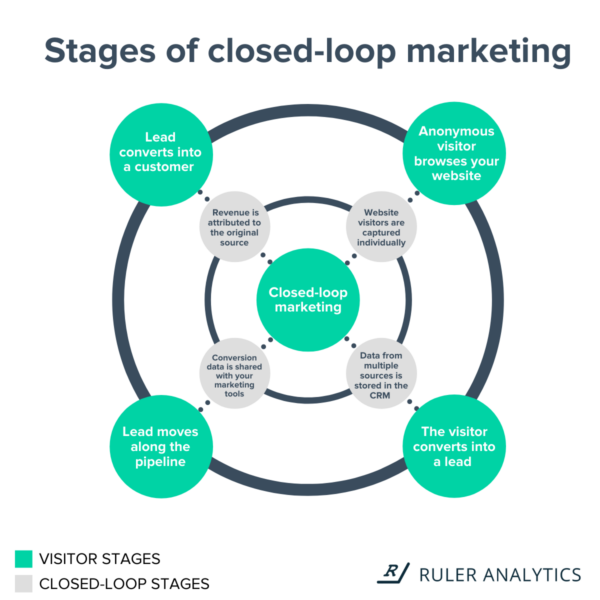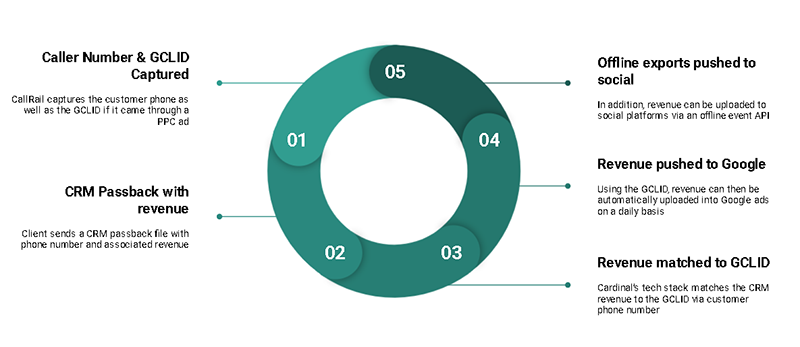It’s the end of the quarter and time to assess marketing’s performance and report to the CEO or board.
Table of Contents
What do you include in your report? Organic traffic volume and leads? Social following and engagement metrics? There’s room for improvement if you only share the ten new mentions on Facebook, one million impressions for the latest branding campaign, and 150 leads from your content marketing activities. You need to understand and report on how many open opportunities and closed-won deals you can attribute to your marketing activities.
What’s the actual return on investment—in real numbers—for all of these channels and campaigns?
These are tough questions, but ones you need to be asking.
What Does Closed-Loop Reporting Mean?
Let’s take a common healthcare marketing metric, new patient leads, and break it down. A lot of organizations are very good at driving new leads from digital marketing. They can launch structured and efficient paid media campaigns. Where they struggle is what comes afterward. If you have 250 new leads generated from paid media, how many become actual patients?
Answering that question is the goal of closed-loop reporting in a nutshell. You’re attributing the revenue that results from a “conversion” and attributing it back to the channels, campaigns, keywords (and more) that influenced it along the way. That information can help determine which marketing activities are creating the most sales. It can also put you in a better position to move more conversions over the finish line.
What Do You Need to Achieve Closed-Loop Reporting?
The challenge here is to track users individually, gather data about their activities from start to finish, then bring that data together into a single connected platform (your CRM or revenue management platform, perhaps) so that various teams can benefit from reliable attribution data.
Here’s how one solution provider, Ruler Analytics, visualized closed-loop marketing in practice:

As this graphic neatly illustrates, a few core activities comprise closed-loop marketing, namely: website visitor tracking; revenue attribution; data integration and storage; and extending data to various sales and marketing tools.
The Benefits of Closed-Loop Reporting
From sales to marketing and beyond, your organization will benefit from closed-loop reporting in several ways. You’ll gain new customer insights backed by reliable data, for one. If you know, for example, that very few patients leads coming from social media end up booking a new appointment for a high-revenue plastic surgery procedure, you can begin piecing together clues as to why.
Maybe your investments are better directed to another marketing channel. And maybe there are some yet untapped opportunities to strengthen the post-purchase relationship with customers based on these insights.
Healthcare marketing teams empowered by closed-loop can allocate budgets better and with greater confidence. This can contribute to a reduced cost per lead, a holy grail of sorts in the healthcare marketing world. Then of course, there’s the ability to present better ROI calculations for marketing activities to executive stakeholders.
Measurement & “Actionable” Reporting
The line between a marketing qualified lead (MQL) and sales qualified lead (SQL) is often unclear. Amber Kemmis, writing for SmartBug, points out a gap between the lead and opportunity stages in the customer lifecycle where MQLs and SQLs sit. Each one must meet different criteria to be classified as “MQL” or “SQL,” which is up to your organizational stakeholders from each team to define.
In defining MQLs and SQLs, Kemmis asks us to consider lead behavior, demographics, and scoring. In this context, closed-loop reporting provides a measurement and reporting continuum from MQL to SQL.

Of course, there are other metrics we’ll need to follow as part of our closed-loop reporting discipline, including:
- Visitor-to-Lead Conversion Rate (VTL%)
- Lead-to-Customer Rate (LTC%)
- Visitor-to-Customer Rate (VTC %)
Again, the idea is to turn these metrics into insights and real business decisions—to measure, review, and plan accordingly. As noted, this will require closely connected business systems, including your CRM, data and analytics solution, and marketing platform.
Attribution From Data Insights
I mentioned marketing touchpoints along a healthcare consumer’s so-called “path to purchase.” Connecting those various marketing engagements with their related sales activities is what attribution is all about. That is, which of these touchpoints have an impact on the final “sale,” and to what measurable extent?

Your attribution model will play a central role in the strength and comprehensiveness of your closed-loop reporting. To that end, here are a few attribution models you might consider using:
- First-touch: Gives credit to the very first touchpoint that the converted lead engaged with.
- Last-touch: Gives credit to the very last touchpoint that a converted lead engaged with.
- Linear: Here, credit is divided up equally across every touchpoint involved. Indicative characterizes the linear attribution model as giving “a participation award to every marketing channel a business used.”
- Multi-touch: Gives partial conversion credit to a variety of marketing channels and touchpoints, each variously weighted.
- Time-Decay: Some credit is assigned to every “touch” that led to a conversion, with credit weighted in favor of more recent touches.
- U-Shaped: The first and last marketing touches get the most weight, with the middle touches receiving less weight.
- W-Shaped: This model gives 30 percent credit to the first, middle, and last touches, then 10 percent to the remaining touches in between.
You’ve certainly got options. Keep in mind that the number of marketing channels you use, as well as the length of your sales cycle, will impact whichever attribution model you use. Simply put, longer sales cycles have more touchpoints, which affects how you weigh the value of marketing activities and even which attribution model you use. If your patients move through a long buyer’s journey, only considering the last touchpoint means you could overlook how people initially discovered your brand.
Last-touch attribution makes more sense when the buyer’s journey is short or not long considered, say for urgent care.
Ties to Organizational Goals
One of the most impactful outcomes of mature closed-loop reporting is the ability to connect this data to broader forecasting and strategic planning. The insights you derive from closed-loop reporting can help drive resource planning, patient scheduling, and financial planning. There’s a confidence that comes with such a complete, comprehensive, and reliable approach that involves stakeholders from marketing, operations, and the C-suite.
Some Healthcare-Specific Challenges to Attribution
Whereas the potential upsides of this approach to attribution are many, so are the challenges. Not all consumer activity is trackable, an obstacle that’s magnified in the healthcare space. For example, people often share information and links via “dark” channels like Reddit, Facebook Messenger, text, and other direct messaging channels. Or they simply call up their Mom and ask for a doctor recommendation.
Traffic from these links often shows as “direct” in attribution software, making attribution a little more complicated. People will also read articles or see ads and then look things up themselves later via branded searches, rather than clicking an ad. As a result, that new lead gets lumped into “SEO” in attribution software.
Another challenge in the healthcare space is that a lot of data is still transmitted through analog channels, like fax. New patient referrals may be sent via fax and their information must be manually entered into an electric health record system.
So it’s not always a “clean” data set or complete picture.
Then, of course, there’s the ever-decreasing availability of data overall. Developments like the iOS14 update, iOS15 update, and the move to cookieless browsers come to mind. On top of that, healthcare providers must always comply with HIPAA and other healthcare-specific data privacy regulations.
These limitations often make it challenging to integrate healthcare technology with the attribution software needed for closed-loop reporting. Not all technologies can integrate with healthcare platforms to ensure HIPAA compliance, for example. And when direct integration is not possible, you must manually upload new customer lists into attribution software to close the loop, which is very time-consuming.

The good news is that you can manually close the loop. It’s possible! In Episode 21 of the Ignite Digital Marketing Podcast, I tackle this issue with Richard Braddock, our SVP of Performance Marketing. Here’s what he had to say on the matter, which should provide some inspiration:
“The easiest way to do it in a manual fashion would probably be phone calls. If you have a call tracking solution, you can essentially see where the source of that call came in from. If you have CallRail, it can tell you that lead originated from Google Ads on a specific landing page. Or it originated from an SEO session on the website. It originated from a Google PPC call extension. It will tell you all these things, right?
If you know where it came from, then you could match the caller’s phone number against the phone numbers that you have in your CRM, if you have a CRM or a PMS, if you have a PMS where you’re tracking what happened to that lead, so if it became a patient. In theory, you could download a list of all your new patients for the last 90 days, go to CallRail, look at the customer phone numbers in your PMS or your CRM, match it against the phone numbers in CallRail, and you’d get roughly what source they came in from.”
It takes some work to implement, but it’s worth it. Uploading customer data to your Google Ads or Facebook Ads account helps machine learning algorithms understand what ads were most effective at generating actual patients. With that insight, they can optimize the campaigns to do more of the same (attract and convert the best leads).
Have you thought about how call tracking fits into your tracking and attribution? I highly recommend listening to this podcast for more insights into tracking and measurement strategies for healthcare.
A Patient-First Approach Goes a Long Way
There’s a tendency for marketing teams to get swept up in what the numbers mean to the team- or organization-level objectives. “Yes, but what about ROI? What about marketing-attributed revenue?” Remember that whole deal?
There’s another way to look at this, though. Closed-loop reporting can tell you a ton about your patient experience. It can reveal patient intent, needs, and concerns. It can reveal sticking points and high-frustration moments in the journey. If your organization’s end goal is to deliver better patient outcomes, then you already have your most important argument in support of closed-loop reporting.

